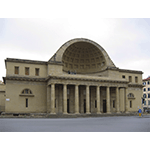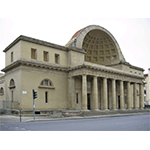Cisternone di Livorno [Large Cistern of Livorno]
An impressive building in the neoclassical style, the "Cisternone" was designed by Arezzo architect Pasquale Poccianti and inaugurated by Grand Duke Leopold II of Lorraine in 1842. The large cistern, whose construction began in 1828, was intended to filter the water from the springs of Colognole and guarantee the supply of water to the city, in case of aqueduct malfunction. The cistern measures 38 metres in width, 42 metres in length, and has a capacity of 11,000 cubic metres.
In his Guida di Livorno, Giuseppe Piombanti describes the building, «On crossing the threshold, one enters a semicircular atrium. In the room on the left, from a massive cast-iron tube that reaches all the way to the Little Cistern of Pian di Rota, flows the water of Colognole, while below the atrium are the canals that take it to the Little Cistern and the other fountains. In front of the middle door of the atrium extends the large cistern of five aisles in width and seven in length; the last of these, separated by an intermediate wall, is the first to receive the waters, severing as a sort of purgatory, and then pours them into the internal repository».
The facade of the recently restored building presents a characteristic half cupola. A curiosity: the affairs in the construction of Livorno’s water system are celebrated in a bas-relief sculpted on the base of the statue erected in honour of Grand Duke Ferdinando III of Lorraine in Piazza della Repubblica. The statue was executed by Portoferraio sculptor Francesco Pozzi between 1831 and 1837, while the bas-relief depicting the Grand Duke urging the construction of the Colognole aqueduct is by Temistocle Guerrazzi from Livorno. The other bas-relief portraying Ferdinando III promoter of the arts, industry and commerce, was sculpted by Ulisse Cambi from Florence.
****************************
Texts by Graziano Magrini
English translation by Victor Beard
Last update 14/gen/2008





